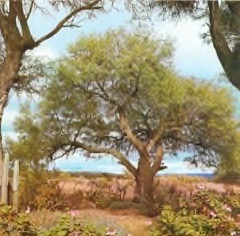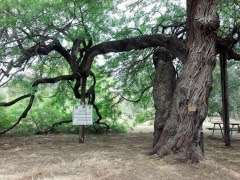 |
|
Wikimedia.org - Mr. Jorge Vallmitjana |
 |
| Wikimedia.org - PMATAS |
Translate this page:
Summary
Prosopis species,
Prosopis are nitrogen fixers in the legume family (Fabaceae) that often thrive in arid soil and are drought-resistant. Their fruits are pods that can contain large amounts of sugar and are a balanced staple carbohydrate. Harvested in autumn and winter, White Carob Tree (P. alba) pods can be eaten as fresh fruit or conserved in their sweet fresh juice. Dried and ground pods make flour for making cakes. The popular drink ‘Aloja’ is prepared with fresh, sweet-tasting pods. Prosopis alba can reportedly tolerate drought, salt and sand; in fact, it is extremely efficient with regards to water consumption, it produces the most fruits in years of drought and has been successfully introduced in arid terrains.
Physical Characteristics

 Prosopis alba is a deciduous Tree growing to 10 m (32ft) by 10 m (32ft) at a medium rate.
Prosopis alba is a deciduous Tree growing to 10 m (32ft) by 10 m (32ft) at a medium rate.
See above for USDA hardiness. It is hardy to UK zone 10. The flowers are pollinated by Bees. The plant is not self-fertile.
It can fix Nitrogen.
It is noted for attracting wildlife.
Suitable for: light (sandy), medium (loamy) and heavy (clay) soils, prefers well-drained soil and can grow in nutritionally poor soil. Suitable pH: mildly acid, neutral and basic (mildly alkaline) soils and can grow in saline soils.
It cannot grow in the shade. It prefers dry or moist soil and can tolerate drought. The plant can tolerates strong winds but not maritime exposure.
UK Hardiness Map
US Hardiness Map
Synonyms
Prosopis atacamensis Phil. Prosopis siliquastrum longisiliqua Phil.
Plant Habitats
Edible Uses
Edible Parts: Seedpod Stem
Edible Uses: Drink Gum Sweetener
Pod - fresh or dried[418 ]. The pod can be eaten as a fresh fruit or conserved in its own sweet fresh juice[418 ]. If the pod is dried then ground into a powder, it gives a flour that can be mixed with a little water and eaten immediately or used for making cakes[317 , 418 ]. The popular drink 'aloja' is prepared with the fresh, sweet tasting pods[317 ]. A gum obtained from the stems has a soft consistency and a sweet flavour. It is used as a candy[303 ]. Staple crop: balanced Carb.
References More on Edible Uses
Medicinal Uses
Plants For A Future can not take any responsibility for any adverse effects from the use of plants. Always seek advice from a professional before using a plant medicinally.
Antibacterial Antiseptic Dysentery Emollient
Leaf extracts have shown antibacterial activity[418 ]. The bark, branches, gum and foliage are antiseptic, antidysenteric and emollient[418 ]. They are used as a treatment against gastritis[418 ]
References More on Medicinal Uses
The Bookshop: Edible Plant Books
Our Latest books on Perennial Plants For Food Forests and Permaculture Gardens in paperback or digital formats.

Edible Tropical Plants
Food Forest Plants for Hotter Conditions: 250+ Plants For Tropical Food Forests & Permaculture Gardens.
More

Edible Temperate Plants
Plants for Your Food Forest: 500 Plants for Temperate Food Forests & Permaculture Gardens.
More

More Books
PFAF have eight books available in paperback and digital formats. Browse the shop for more information.
Shop Now
Other Uses
Charcoal Fodder Fuel Furniture Gum Shelterbelt Soil conditioner Soil reclamation Soil stabilization Tannin Wood
Agroforestry Uses: The nitrogen fixing properties, rapid growth and deep roots make this a suitable species for erosion control and soil improvement[418 ]. The tree is planted in reclamation schemes for salt-affected soils[317 ]. Windbreak. Other Uses: A gum obtained from the trunk has physical and chemical properties similar to gum arabic (Acacia spp.)[418 ]. The bark is rich in tannins[317 ]. The wood contains 5 - 9% tannins[303 ]. The heartwood is reddish-brown; the sapwood yellowish[303 ]. The wood is fairly dense and difficult to work[303 , 414 ]. It is used for parquet floors, doors and furniture[325 , 414 ]. The wood is excellent for both firewood and charcoal[325 , 414 , 418 ]. 1. Nectary - Flowers rich in nectar and pollen:
Yes – Mesquite flowers produce nectar and pollen that attract bees and other pollinators, including beneficial insects.
2. Wildlife - Food (Fruit, Seeds, Leaf litter, Shelter, Nesting, Roosting):
Yes – Mesquite pods are consumed by animals, including birds and mammals. The tree provides dense foliage that can serve as shelter and nesting sites for wildlife. The seeds also offer a food source for various species.
3. Invertebrate Shelter (Overwintering sites, Leaf litter, Groundcover):
Yes – The rough bark, fallen pods, and leaf litter provide shelter and overwintering sites for invertebrates, while the groundcover helps maintain beneficial insect populations.
4. Pest Confuser (Smell):
No – Mesquite does not have a strong scent that would act as a pest confuser.
Special Uses
Carbon Farming Coppice Food Forest Nitrogen Fixer
References More on Other Uses
Cultivation details
Agroforestry Services: Nitrogen Agroforestry Services: Windbreak Fodder: Pod Management: Coppice Management: Standard Regional Crop Staple Crop: Balanced carb
A plant mainly of the dry subtropical zone, extending into the tropics at higher elevations in Bolivia and Peru. (though it is found at elevations as low as 360 metres at latitude 18°S in Bolivia). It grows best in areas where annual daytime temperatures fall within the range 10 - 20°c, though it can tolerate 7 - 28°c and an absolute maximum of 45°c[418 ]. Mature specimens can tolerate occasional short-lived temperatures down as low as -6°c, though younger plants can be killed at -1°c[418 ]. It prefers a mean annual rainfall in the range 200 - 500mm, tolerating 100 - 700mm[418 ]. Requires a sunny position[418 ]. Succeeds in most soils so long as they are well-drained[418 ]. Tolerates somewhat saline soils[325 ]. Prefers a pH in the range 5 - 6.5, tolerating 4.5 - 7[418 ]. Established plants are very drought tolerant[418 ]. Under optimal conditions, a large tree (40 cm in basal diameter and 7 m in canopy diameter) may produce 40 kg of pods[325 ]. Some forms of this plant are thorn-free[414 ]. This species has a symbiotic relationship with certain soil bacteria; these bacteria form nodules on the roots and fix atmospheric nitrogen. The growing plant utilizes some of this nitrogen, but some can also be used by other plants growing nearby[755 ]. Mesquite pods are typically harvested in late Summer to Autumn, depending on the species and environmental conditions.
Mesquite trees flower in Spring, usually from April to June (Northern Hemisphere). Mesquite trees are fast growers, often reaching heights of 4-10 meters (12-35 feet) in just a few years, depending on the species and environmental conditions.
Carbon Farming
-
Agroforestry Services: Nitrogen
Plants that contribute to nitrogen fixation include the legume family – Fabaceae.
-
Agroforestry Services: Windbreak
Linear plantings of trees and shrubs designed to enhance crop production, protect people and livestock and benefit soil and water conservation.
-
Fodder: Pod
Fodder plants with pods.
-
Management: Coppice
Cut to the ground repeatedly - resprouting vigorously. Non-destructive management systems maintaining the soil organic carbon.
-
Management: Standard
Plants grow to their standard height. Harvest fruit, seeds, or other products. Non-Destructive management systems.
-
Regional Crop
These crops have been domesticated and cultivated regionally but have not been adopted elsewhere and are typically not traded globally, Examples in this broad category include perennial cottons and many nuts and staple fruits.
-
Staple Crop: Balanced carb
(0-15 percent protein, 0-15 percent oil, with at least one over 5 percent). The carbohydrates are from either starch or sugar. Annuals include maize, wheat, rice, and potato. Perennials include chestnuts, carob, perennial fruits, nuts, cereals, pseudocereals, woody pods, and acorns.
References Carbon Farming Information and Carbon Sequestration Information
Temperature Converter
Type a value in the Celsius field to convert the value to Fahrenheit:
Fahrenheit:
The PFAF Bookshop
Plants For A Future have a number of books available in paperback and digital form. Book titles include Edible Plants, Edible Perennials, Edible Trees,Edible Shrubs, Woodland Gardening, and Temperate Food Forest Plants. Our new book is Food Forest Plants For Hotter Conditions (Tropical and Sub-Tropical).
Shop Now
Plant Propagation
Seed - it remains viable for several years in normal storage[325 ]. The seeds are hardcoated and must be scarified in order to germinate. Burning, nicking and immersion in boiling water are some of the methods that can be used. If the seeds are not extracted from the pods before sowing, they will normally require several minutes of boiling to overcome dormancy. Normally the seeds are sown directly in containers. Germination starts after 2 weeks and continues for up to one month. When the plants are 30 - 35cm tall they are ready for planting in the field[325 ]. Direct seeding is also possible[325 ]. Seed need to be inoculated with mesquite rhizobia. Competes well with grasses and shrubs.
Other Names
If available other names are mentioned here
Algarrobo blanco, Argentine mesquite, Cupesi, Huancu, Huilca, Ibope, igope, Ogope, Jwa'ayuk, Najnuna, Pohon algoroba putih, Pohon karob putih, Tacu, Thaco, Yana-tacu,Yurakk takko
Native Range
SOUTHERN AMERICA: Bolivia, Chuquisaca, La Paz, Santa Cruz, Tarija (south), Peru, Arequipa, Huancavelica, Argentina, Córdoba, Buenos Aires, Chaco, Corrientes, Entre Ríos, Jujuy, Salta, San Luis, Santa Fe, Santiago del Estero, Tucumán, Paraguay,
Weed Potential
Right plant wrong place. We are currently updating this section.
Please note that a plant may be invasive in one area but may not in your area so it's worth checking.
None Known
Conservation Status
IUCN Red List of Threatened Plants Status : Status: Lower Risk/near threatened

Growth: S = slow M = medium F = fast. Soil: L = light (sandy) M = medium H = heavy (clay). pH: A = acid N = neutral B = basic (alkaline). Shade: F = full shade S = semi-shade N = no shade. Moisture: D = dry M = Moist We = wet Wa = water.
Now available:
Food Forest Plants for Mediterranean Conditions
350+ Perennial Plants For Mediterranean and Drier Food Forests and Permaculture Gardens.
[Paperback and eBook]
This is the third in Plants For A Future's series of plant guides for food forests tailored to
specific climate zones. Following volumes on temperate and tropical ecosystems, this book focuses
on species suited to Mediterranean conditions—regions with hot, dry summers and cool, wet winters,
often facing the added challenge of climate change.
Read More
Expert comment
Author
Griseb.
Botanical References
Links / References
For a list of references used on this page please go here
A special thanks to Ken Fern for some of the information used on this page.
Readers comment
| Add a comment |
|
If you have important information about this plant that may help other users please add a comment or link below. Only comments or links that are felt to be directly relevant to a plant will be included. If you think a comment/link or information contained on this page is inaccurate or misleading we would welcome your feedback at [email protected]. If you have questions about a plant please use the Forum on this website as we do not have the resources to answer questions ourselves.
* Please note: the comments by website users are not necessarily those held by PFAF and may give misleading or inaccurate information.
To leave a comment please Register or login here All comments need to be approved so will not appear immediately.
|
|